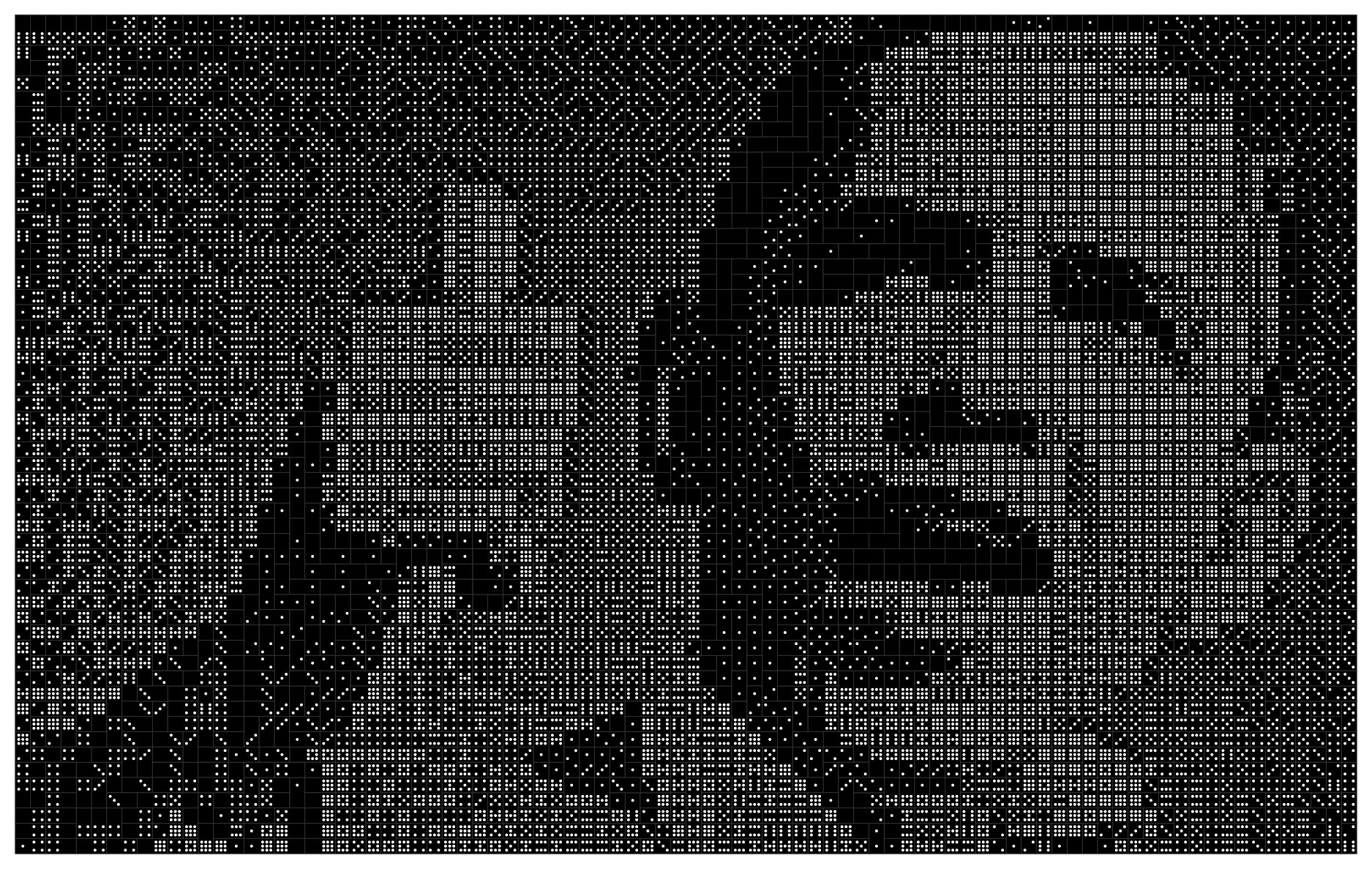Art
The Mathematics of Opt Art – Scientific American

It’s no secret that constraints can help artists unlock their creativity. The Oulipo literary movement embraces constraints like writing a novel without the letter e; painter Piet Mondrian created iconic works of art using only primary colors within rectilinear black and white grids; 12-tone serialism in music, in which composers set strict rules for themselves about which notes can occur in which order in their work. In all of these endeavors, constraints helped artists find creative solutions to their artistic puzzles. In his recent book Opt Art, Robert Bosch describes the constraints he applies to the art he creates and the computational and mathematical tools with which he satisfies those constraints.
Each chapter introduces an optimization problem—e.g. approximating images using particular tiles—and an accessible explanation of how to translate the problem into the language of mathematics and solve it using computational tools.
Many of the examples in the book are mosaics made using different types of tiles. French priest and mathematician Sébastien Truchet appears in a portrait using modified Truchet tiles, and Barack Obama is made of 44 complete sets of double-9 dominoes. (As those examples indicate, his work is frequently playful.)
Other pieces use the traveling salesman problem instances or knight’s tours to create line art. The traveling salesman problem is to find the shortest path between a given number of points or cities, and a knight’s tour is a path on a chessboard that visits every square exactly once using moves knights can make in chess. (I wrote about Bosch’s TSP art in 2015. It was my introduction to his work, and I’ve been a fan ever since.)
For many image types, the basic idea is to pixelate the image using a grid of the desired resolution and approximate each pixel with the type of tile you’re using. This technique makes the problems discrete, so, the tools to solve them come from the field of linear optimization. From a finite number of possible arrangements of tiles or lines connecting a group of points, can we find one that minimizes or maximizes particular quantities we have chosen?
While it’s fun to learn about the math and programming tools, I thought the most valuable thing about the book was the way Bosch gives us a peek into the more subjective side of his work: how he chooses what constraints to use with what media, and the different results that can happen when he makes different choices.

Opt Art is a fairly quick read, in part because it is so chock full of illustrations and in part because the mathematical techniques Bosch uses are at their core fairly simple. In some ways, the book is a tribute to the way the same few ideas from linear algebra can be applied to different problems to get a wide array of different results. (To be clear, this is not intended to trivialize Bosch’s work at all; I think there are an awful lot of important research projects that boil down to using the same few ideas from linear algebra to solve problems in different domains in engineering, math, and science!)
Opt Art could be a good resource for an introductory course in linear optimization or for inspiration in a project-based linear algebra class. The writing is inviting, and Bosch gives motivated students and other readers the tools they will need to jump right in and start creating their own mosaics or other images using his ideas.
For those following along with my Math Reading Challenge, try this book for prompts 4 or 9. Very precocious babies can use it for prompt 2.
Art
Calvin Lucyshyn: Vancouver Island Art Dealer Faces Fraud Charges After Police Seize Millions in Artwork

In a case that has sent shockwaves through the Vancouver Island art community, a local art dealer has been charged with one count of fraud over $5,000. Calvin Lucyshyn, the former operator of the now-closed Winchester Galleries in Oak Bay, faces the charge after police seized hundreds of artworks, valued in the tens of millions of dollars, from various storage sites in the Greater Victoria area.
Alleged Fraud Scheme
Police allege that Lucyshyn had been taking valuable art from members of the public under the guise of appraising or consigning the pieces for sale, only to cut off all communication with the owners. This investigation began in April 2022, when police received a complaint from an individual who had provided four paintings to Lucyshyn, including three works by renowned British Columbia artist Emily Carr, and had not received any updates on their sale.
Further investigation by the Saanich Police Department revealed that this was not an isolated incident. Detectives found other alleged victims who had similar experiences with Winchester Galleries, leading police to execute search warrants at three separate storage locations across Greater Victoria.
Massive Seizure of Artworks
In what has become one of the largest art fraud investigations in recent Canadian history, authorities seized approximately 1,100 pieces of art, including more than 600 pieces from a storage site in Saanich, over 300 in Langford, and more than 100 in Oak Bay. Some of the more valuable pieces, according to police, were estimated to be worth $85,000 each.
Lucyshyn was arrested on April 21, 2022, but was later released from custody. In May 2024, a fraud charge was formally laid against him.
Artwork Returned, but Some Remain Unclaimed
In a statement released on Monday, the Saanich Police Department confirmed that 1,050 of the seized artworks have been returned to their rightful owners. However, several pieces remain unclaimed, and police continue their efforts to track down the owners of these works.
Court Proceedings Ongoing
The criminal charge against Lucyshyn has not yet been tested in court, and he has publicly stated his intention to defend himself against any pending allegations. His next court appearance is scheduled for September 10, 2024.
Impact on the Local Art Community
The news of Lucyshyn’s alleged fraud has deeply affected Vancouver Island’s art community, particularly collectors, galleries, and artists who may have been impacted by the gallery’s operations. With high-value pieces from artists like Emily Carr involved, the case underscores the vulnerabilities that can exist in art transactions.
For many art collectors, the investigation has raised concerns about the potential for fraud in the art world, particularly when it comes to dealing with private galleries and dealers. The seizure of such a vast collection of artworks has also led to questions about the management and oversight of valuable art pieces, as well as the importance of transparency and trust in the industry.
As the case continues to unfold in court, it will likely serve as a cautionary tale for collectors and galleries alike, highlighting the need for due diligence in the sale and appraisal of high-value artworks.
While much of the seized artwork has been returned, the full scale of the alleged fraud is still being unraveled. Lucyshyn’s upcoming court appearances will be closely watched, not only by the legal community but also by the wider art world, as it navigates the fallout from one of Canada’s most significant art fraud cases in recent memory.
Art collectors and individuals who believe they may have been affected by this case are encouraged to contact the Saanich Police Department to inquire about any unclaimed pieces. Additionally, the case serves as a reminder for anyone involved in high-value art transactions to work with reputable dealers and to keep thorough documentation of all transactions.
As with any investment, whether in art or other ventures, it is crucial to be cautious and informed. Art fraud can devastate personal collections and finances, but by taking steps to verify authenticity, provenance, and the reputation of dealers, collectors can help safeguard their valuable pieces.
Art
Ukrainian sells art in Essex while stuck in a warzone – BBC.com
[unable to retrieve full-text content]
Ukrainian sells art in Essex while stuck in a warzone BBC.com

Source link
Art
Somerset House Fire: Courtauld Gallery Reopens, Rest of Landmark Closed
The Courtauld Gallery at Somerset House has reopened its doors to the public after a fire swept through the historic building in central London. While the gallery has resumed operations, the rest of the iconic site remains closed “until further notice.”
On Saturday, approximately 125 firefighters were called to the scene to battle the blaze, which sent smoke billowing across the city. Fortunately, the fire occurred in a part of the building not housing valuable artworks, and no injuries were reported. Authorities are still investigating the cause of the fire.
Despite the disruption, art lovers queued outside the gallery before it reopened at 10:00 BST on Sunday. One visitor expressed his relief, saying, “I was sad to see the fire, but I’m relieved the art is safe.”
The Clark family, visiting London from Washington state, USA, had a unique perspective on the incident. While sightseeing on the London Eye, they watched as firefighters tackled the flames. Paul Clark, accompanied by his wife Jiorgia and their four children, shared their concern for the safety of the artwork inside Somerset House. “It was sad to see,” Mr. Clark told the BBC. As a fan of Vincent Van Gogh, he was particularly relieved to learn that the painter’s famous Self-Portrait with Bandaged Ear had not been affected by the fire.
Blaze in the West Wing
The fire broke out around midday on Saturday in the west wing of Somerset House, a section of the building primarily used for offices and storage. Jonathan Reekie, director of Somerset House Trust, assured the public that “no valuable artefacts or artworks” were located in that part of the building. By Sunday, fire engines were still stationed outside as investigations into the fire’s origin continued.
About Somerset House
Located on the Strand in central London, Somerset House is a prominent arts venue with a rich history dating back to the Georgian era. Built on the site of a former Tudor palace, the complex is known for its iconic courtyard and is home to the Courtauld Gallery. The gallery houses a prestigious collection from the Samuel Courtauld Trust, showcasing masterpieces from the Middle Ages to the 20th century. Among the notable works are pieces by impressionist legends such as Edouard Manet, Claude Monet, Paul Cézanne, and Vincent Van Gogh.
Somerset House regularly hosts cultural exhibitions and public events, including its popular winter ice skating sessions in the courtyard. However, for now, the venue remains partially closed as authorities ensure the safety of the site following the fire.
Art lovers and the Somerset House community can take solace in knowing that the invaluable collection remains unharmed, and the Courtauld Gallery continues to welcome visitors, offering a reprieve amid the disruption.
-

 Sports15 hours ago
Sports15 hours agoArmstrong scores, surging Vancouver Whitecaps beat slumping San Jose Earthquakes 2-0
-

 News15 hours ago
News15 hours agoAs plant-based milk becomes more popular, brands look for new ways to compete
-

 News22 hours ago
News22 hours agoCF Montreal finds its groove with 2-1 win over Charlotte
-

 News22 hours ago
News22 hours agoToronto FC downs Austin FC to pick up three much-needed points in MLS playoff push
-

 News12 hours ago
News12 hours agoLabour Minister praises Air Canada, pilots union for avoiding disruptive strike
-

 News12 hours ago
News12 hours agoLooking for the next mystery bestseller? This crime bookstore can solve the case
-

 News15 hours ago
News15 hours agoLiberal candidate in Montreal byelection says campaign is about her — not Trudeau
-

 News15 hours ago
News15 hours agoB.C. victim’s family furious at no-fault insurance regime in motor-vehicle death case


















